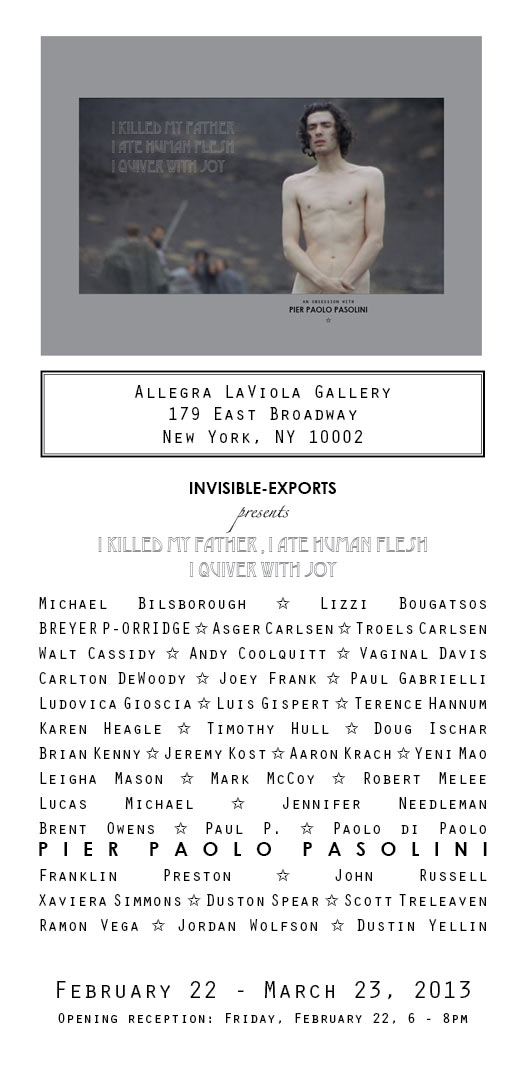I Killed My Father, I Ate Human Flesh, I Quiver With Joy | An Obsession with Pier Paolo Pasolini
I Killed My Father, I Ate Human Flesh, I Quiver With Joy | An Obsession with Pier Paolo Pasolini
Featuring work by Michael Bilsborough, Lizzi Bougatsos, BREYER P-ORRIDGE, Asger Carlsen, Troels Carlsen, Walt Cassidy, Andy Coolquitt, Vaginal Davis, Carlton DeWoody, Joey Frank, Paul Gabrielli, Ludovica Gioscia, Luis Gispert, Terence Hannum, Karen Heagle, Timothy Hull, Doug Ischar, Brian Kenny, Jeremy Kost, Aaron Krach, Yeni Mao, Leigha Mason, Mark McCoy, Robert Melee, Lucas Michael, Jennifer Needleman, Brent Owens, Paul P., Paolo Di Paolo, Pier Paolo Pasolini, Franklin Preston, John Russell, Xaviera Simmons, Duston Spear, Scott Treleaven, Ramon Vega, Jordan Wolfson, Dustin Yellin
DATES:
February 22 – March 24, 2013
RECEPTION:
Friday, February 22, 2013
INVISIBLE-EXPORTS is pleased to present I Killed My Father, I Ate Human Flesh, I Quiver With Joy | An Obsession with Pier Paolo Pasolini at Allegra LaViola Gallery, New York.
* * *
Pier Paolo Pasolini – the filmmaker, poet, sentimental leftist, and transgressive legend – lived a life marked by curious contradiction and unimpeachable integrity. Sculpted by a nomadic Italian childhood filled with religion, war, Socialism, Facism, and run-ins with the law, Pasolini reconceived, in a prodigious obsessive body of remarkably diverse work, the entire patrimony of post-WWII-Italy as a personal mythology refracted by the urgent demands of modern continental life and contemporary politics in an age of extremes.
Beginning with his first film, Accatone (1961) on through to the game-changing Sálo (1975), Pasolini worked in an era in which avant-garde artistic gestures felt still truly dangerous, in which artists retained the power to shock, and in which the imposition of a personal artistic vision felt still like a radical, rather than narcissistic, act. Pasolini made the most of that power, and has become in the decades since an object of personal obsession for thousands of contemporary artists, many of whom offer up here, in a showcase that is as much open tribute as it is narrow appreciation, their own idiosyncratic homage to a person who has had an outsized influence on a whole generation enamored of radical gestures in a skeptical, ironic age.
Pasolini is a mercurial, even arcane influence on the 37 artists whose work is assembled here—sculptors, photographers, video and multimedia artists, romantics and transgressives, advocacy artists and ironists. The tributes are in some cases straightforward — painted portraits of Pasolini subjects, collage and video sourced from his own work — and in other cases more oblique — sculptures addressing the subject of restraint, watery sketches in which figures dissolve into gothic ethereality. Some are hardly tributes at all—idiosyncratic arguments instead with particular corners of Pasolini’s practice, often revealing far more about the work and obsessions of the contemporary artist than the too-divergent-to-be-uncontradictorially-contained miscellaneous Italian master. The result is a social-networking-style and purposefully-loosely curated exhibition that points in 37 directions at once—possibly more.
